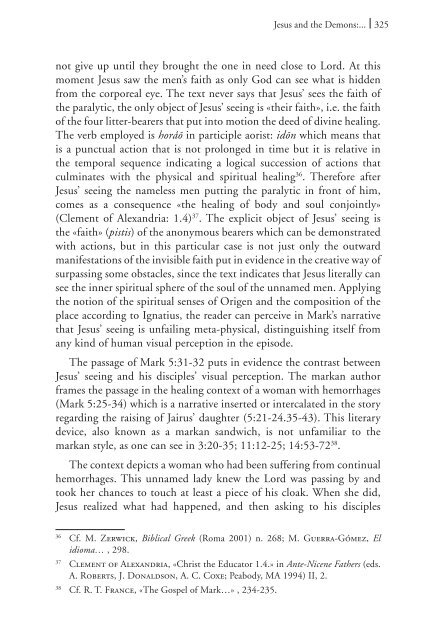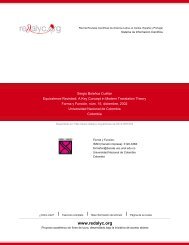Portraits of the spiritual Seeing in Mark's Gospel. Origen ... - Redalyc
Portraits of the spiritual Seeing in Mark's Gospel. Origen ... - Redalyc
Portraits of the spiritual Seeing in Mark's Gospel. Origen ... - Redalyc
Create successful ePaper yourself
Turn your PDF publications into a flip-book with our unique Google optimized e-Paper software.
Jesus and <strong>the</strong> Demons:...<br />
325<br />
not give up until <strong>the</strong>y brought <strong>the</strong> one <strong>in</strong> need close to Lord. At this<br />
moment Jesus saw <strong>the</strong> men’s faith as only God can see what is hidden<br />
from <strong>the</strong> corporeal eye. The text never says that Jesus’ sees <strong>the</strong> faith <strong>of</strong><br />
<strong>the</strong> paralytic, <strong>the</strong> only object <strong>of</strong> Jesus’ see<strong>in</strong>g is «<strong>the</strong>ir faith», i.e. <strong>the</strong> faith<br />
<strong>of</strong> <strong>the</strong> four litter-bearers that put <strong>in</strong>to motion <strong>the</strong> deed <strong>of</strong> div<strong>in</strong>e heal<strong>in</strong>g.<br />
The verb employed is horáō <strong>in</strong> participle aorist: idōn which means that<br />
is a punctual action that is not prolonged <strong>in</strong> time but it is relative <strong>in</strong><br />
<strong>the</strong> temporal sequence <strong>in</strong>dicat<strong>in</strong>g a logical succession <strong>of</strong> actions that<br />
culm<strong>in</strong>ates with <strong>the</strong> physical and <strong>spiritual</strong> heal<strong>in</strong>g 36 . Therefore after<br />
Jesus’ see<strong>in</strong>g <strong>the</strong> nameless men putt<strong>in</strong>g <strong>the</strong> paralytic <strong>in</strong> front <strong>of</strong> him,<br />
comes as a consequence «<strong>the</strong> heal<strong>in</strong>g <strong>of</strong> body and soul conjo<strong>in</strong>tly»<br />
(Clement <strong>of</strong> Alexandria: 1.4) 37 . The explicit object <strong>of</strong> Jesus’ see<strong>in</strong>g is<br />
<strong>the</strong> «faith» (pistis) <strong>of</strong> <strong>the</strong> anonymous bearers which can be demonstrated<br />
with actions, but <strong>in</strong> this particular case is not just only <strong>the</strong> outward<br />
manifestations <strong>of</strong> <strong>the</strong> <strong>in</strong>visible faith put <strong>in</strong> evidence <strong>in</strong> <strong>the</strong> creative way <strong>of</strong><br />
surpass<strong>in</strong>g some obstacles, s<strong>in</strong>ce <strong>the</strong> text <strong>in</strong>dicates that Jesus literally can<br />
see <strong>the</strong> <strong>in</strong>ner <strong>spiritual</strong> sphere <strong>of</strong> <strong>the</strong> soul <strong>of</strong> <strong>the</strong> unnamed men. Apply<strong>in</strong>g<br />
<strong>the</strong> notion <strong>of</strong> <strong>the</strong> <strong>spiritual</strong> senses <strong>of</strong> <strong>Origen</strong> and <strong>the</strong> composition <strong>of</strong> <strong>the</strong><br />
place accord<strong>in</strong>g to Ignatius, <strong>the</strong> reader can perceive <strong>in</strong> Mark’s narrative<br />
that Jesus’ see<strong>in</strong>g is unfail<strong>in</strong>g meta-physical, dist<strong>in</strong>guish<strong>in</strong>g itself from<br />
any k<strong>in</strong>d <strong>of</strong> human visual perception <strong>in</strong> <strong>the</strong> episode.<br />
The passage <strong>of</strong> Mark 5:31-32 puts <strong>in</strong> evidence <strong>the</strong> contrast between<br />
Jesus’ see<strong>in</strong>g and his disciples’ visual perception. The markan author<br />
frames <strong>the</strong> passage <strong>in</strong> <strong>the</strong> heal<strong>in</strong>g context <strong>of</strong> a woman with hemorrhages<br />
(Mark 5:25-34) which is a narrative <strong>in</strong>serted or <strong>in</strong>tercalated <strong>in</strong> <strong>the</strong> story<br />
regard<strong>in</strong>g <strong>the</strong> rais<strong>in</strong>g <strong>of</strong> Jairus’ daughter (5:21-24.35-43). This literary<br />
device, also known as a markan sandwich, is not unfamiliar to <strong>the</strong><br />
markan style, as one can see <strong>in</strong> 3:20-35; 11:12-25; 14:53-72 38 .<br />
The context depicts a woman who had been suffer<strong>in</strong>g from cont<strong>in</strong>ual<br />
hemorrhages. This unnamed lady knew <strong>the</strong> Lord was pass<strong>in</strong>g by and<br />
took her chances to touch at least a piece <strong>of</strong> his cloak. When she did,<br />
Jesus realized what had happened, and <strong>the</strong>n ask<strong>in</strong>g to his disciples<br />
36<br />
Cf. M. Zerwick, Biblical Greek (Roma 2001) n. 268; M. Guerra-Gómez, El<br />
idioma… , 298.<br />
37<br />
Clement <strong>of</strong> Alexandria, «Christ <strong>the</strong> Educator 1.4.» <strong>in</strong> Ante-Nicene Fa<strong>the</strong>rs (eds.<br />
A. Roberts, J. Donaldson, A. C. Coxe; Peabody, MA 1994) II, 2.<br />
38<br />
Cf. R. T. France, «The <strong>Gospel</strong> <strong>of</strong> Mark…» , 234-235.
















